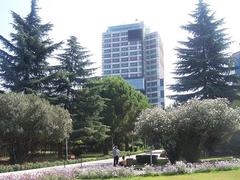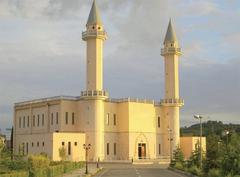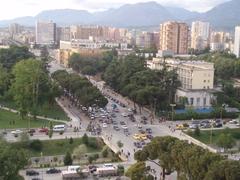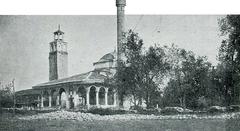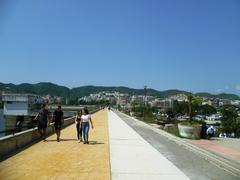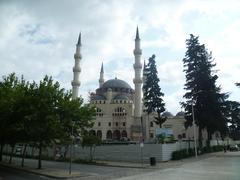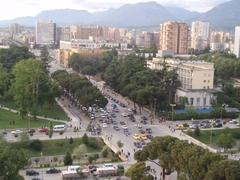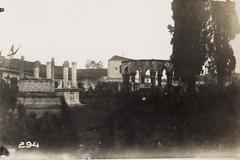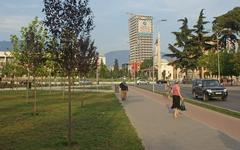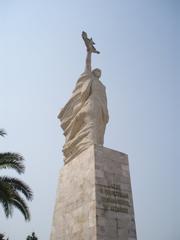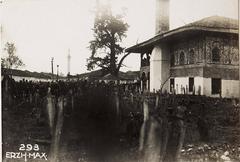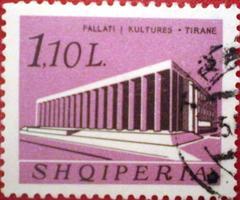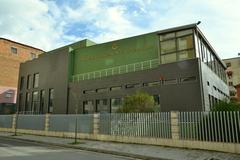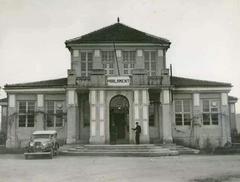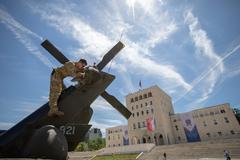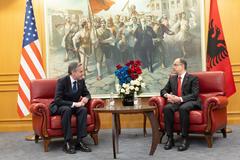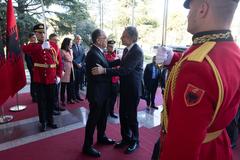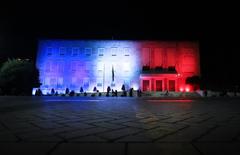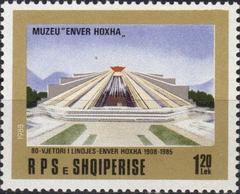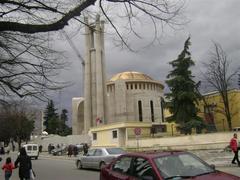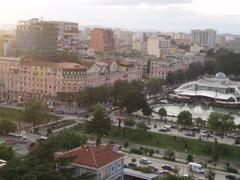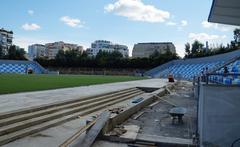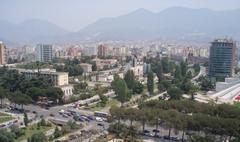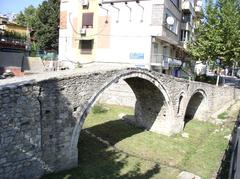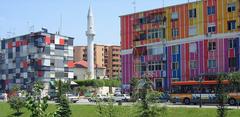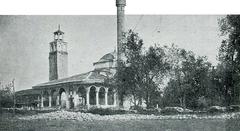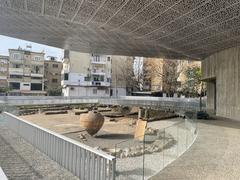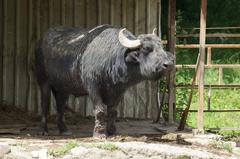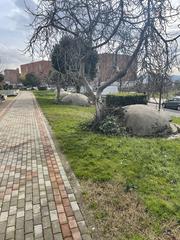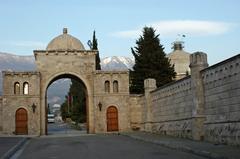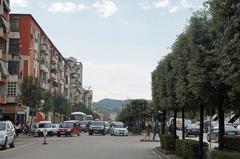University Hospital for Traumatic Injuries Tirana: Visiting Hours, Tickets, and Visitor Information
Date: 14/06/2025
Introduction: Significance and What to Expect
Situated in Tirana, Albania’s vibrant capital, the University Hospital for Traumatic Injuries—locally known as “Spitali Universitar i Traumës”—is the nation’s principal trauma referral center and a key institution for medical education. Established in the aftermath of World War II, the hospital began as a military facility and has since transformed into a leading civilian trauma and academic center. Its strategic affiliation with the University of Medicine, Tirana, highlights its dual mission: delivering advanced trauma care and training the next generation of medical professionals.
While the hospital is not a traditional tourist attraction, it is of significant interest to medical professionals, students, and those keen to learn about Albania’s healthcare advancements. Visitors can expect insights into Albania’s evolving medical landscape, opportunities to explore its medical heritage, and, on occasion, access to guided educational tours. The hospital is located in the Laprakë district and is easily accessible from the city center.
For further reading on Albanian trauma care and the hospital’s development, see PMC5055520 and PMC7901006.
Article Contents
- Introduction and Historical Context
- Founding and Development
- Institutional Evolution and Academic Integration
- Role in National Healthcare
- Modernization and International Partnerships
- Key Milestones
- Visitor Information: Hours, Access, and Entry
- Location & Transportation
- Facilities and Visitor Services
- Nearby Attractions
- Frequently Asked Questions (FAQ)
- Visual Highlights
- Summary and Final Tips
- Sources
Founding and Development
Established in post-World War II Albania, the hospital was created to address the increasing demand for specialized trauma and emergency care. Its origins as a military hospital reflected Albania’s focus on expanding tertiary healthcare services during rapid urbanization and industrialization. Early on, the hospital responded to a surge in trauma cases related to road and workplace accidents, setting the stage for its future as a civilian trauma center (PMC5055520).
Institutional Evolution and Academic Integration
From inception, the hospital has combined clinical practice and academic training. As an affiliate of the University of Medicine, Tirana, it trains medical students, surgeons, and emergency medicine specialists. Participation in international trauma care initiatives has further enhanced its educational mission and fostered global knowledge exchange (PMC7901006).
Role in National Healthcare
As the country’s primary trauma referral center, the hospital plays a central role in managing Albania’s trauma burden. It treats complex cases from across the nation, including victims of traffic accidents, industrial injuries, and mass casualty incidents. The hospital also advocates for the development of prehospital emergency services and first responder training, addressing challenges such as resource limitations and underdeveloped ambulance networks (PMC5055520).
Modernization and International Partnerships
Recent years have brought significant modernization, with investments in new medical equipment, telemedicine, and staff training—often supported by agencies like USAID. The hospital’s participation in European and international trauma networks has facilitated the adoption of best practices and quality indicators (PMC7901006).
Key Milestones
- Expansion into advanced trauma surgery, neurosurgery, orthopedics, and critical care.
- Leadership in training trauma surgeons and emergency physicians.
- Pioneering telemedicine to extend trauma care to remote areas.
- Active participation in international research and implementation of evidence-based protocols (PMC5055520, PMC7901006).
Visitor Information: Hours, Access, and Entry
Visiting Hours:
- General visiting hours are typically in the afternoon and early evening (2:00 PM to 8:00 PM), but may vary by department and patient condition.
- The Emergency Department operates 24/7, with visitor access limited to immediate family under exceptional circumstances.
Entry Requirements:
- Admission is free; identification may be required at security checkpoints.
- Visitors must comply with hospital protocols, including privacy and infection control guidelines.
Tour Arrangements:
- The hospital occasionally offers guided educational tours for medical professionals and students, which must be arranged in advance through administration.
Location and Transportation
The hospital is located in the Laprakë district at Rruga e Dibrës, Tirana, Albania. It is accessible by public transport, taxi, or private vehicle. For navigation, consult Mapcarta, which provides interactive maps and directions.
Facilities and Visitor Services
- Navigation: The hospital comprises multiple buildings; signage is primarily in Albanian, with some staff speaking English or Italian.
- Accessibility: Facilities are wheelchair-accessible. Visitors with special needs should contact the hospital ahead of time.
- Security: Access is controlled to ensure patient safety.
Nearby Attractions
Combining your visit with exploration of Tirana’s cultural landmarks is recommended. Notable sites include:
- Skanderbeg Square: The city’s main plaza, surrounded by historic institutions.
- National History Museum: Chronicling Albania’s past from antiquity to the present.
- Et’hem Bey Mosque: A beautifully preserved Ottoman-era mosque.
- Tirana Castle: The Fortress of Justinian, an ancient defensive structure offering cultural events and exhibitions (Official Tirana Tourism Website, Tirana Castle on TripAdvisor).
Frequently Asked Questions (FAQ)
Q: Can tourists visit the hospital?
A: The hospital is a working medical facility, but guided educational visits may be arranged in advance.
Q: Are there medical tourism services?
A: The hospital focuses on trauma care and education; medical tourism is limited.
Q: What languages are spoken by staff?
A: Albanian is primary, with some staff speaking English and Italian.
Q: Is there parking?
A: Limited on-site parking is available; public transportation is recommended.
Q: Are there exhibitions or a museum?
A: No dedicated museum, but occasional exhibitions and educational events are held.
Visual Highlights
- Images of the hospital exterior and historical photos.
- Photographs of modern operating rooms and telemedicine facilities.
- Interactive campus map via Mapcarta.
Summary and Final Tips
The University Hospital for Traumatic Injuries in Tirana is a testament to Albania’s progress in trauma care and medical education. Its transformation from a military hospital to a national trauma center reflects both the challenges and achievements of the country’s healthcare system. While primarily serving patients and healthcare professionals, guided visits offer a unique perspective for those interested in medical history or public health.
Plan ahead by contacting the hospital administration for visits, and use resources like official tourism platforms and the Audiala app for additional guidance and updates. Enhance your experience by exploring Tirana’s rich array of historical and cultural sites nearby (PMC5055520, PMC7901006).
Sources and Official Links
- Trauma Care in Albania, 2016, J. Xhafa et al.
- Academic Trauma Centers: International Perspectives, 2021, A. R. Smith et al.
- Visiting the University Hospital for Traumatic Injuries in Tirana: A Guide for Visitors, 2024, Tirana Health Tourism Board
- Official Tirana Tourism Website
- Tirana Castle on TripAdvisor
- Explore More Albanian Historical Sites
